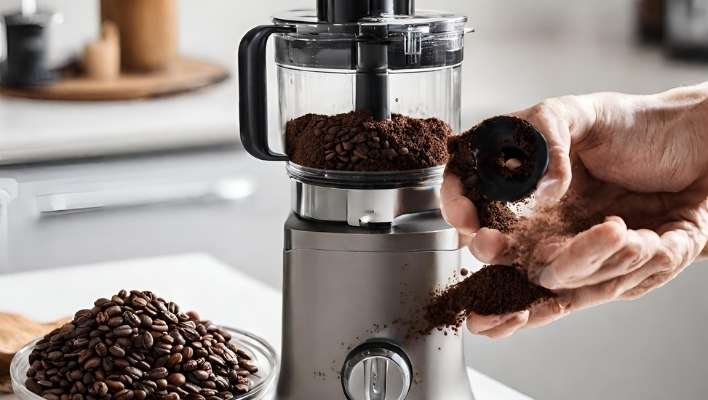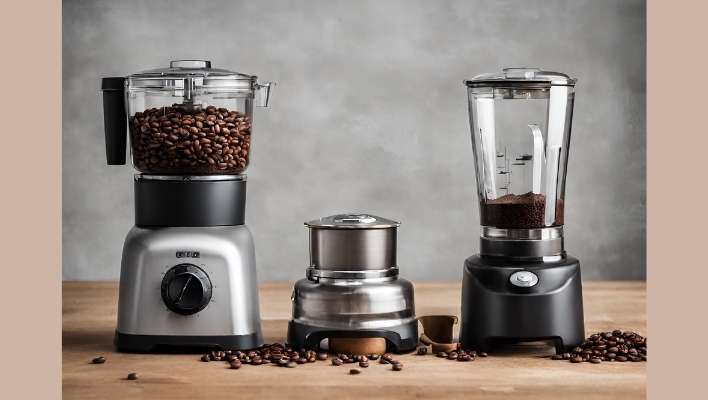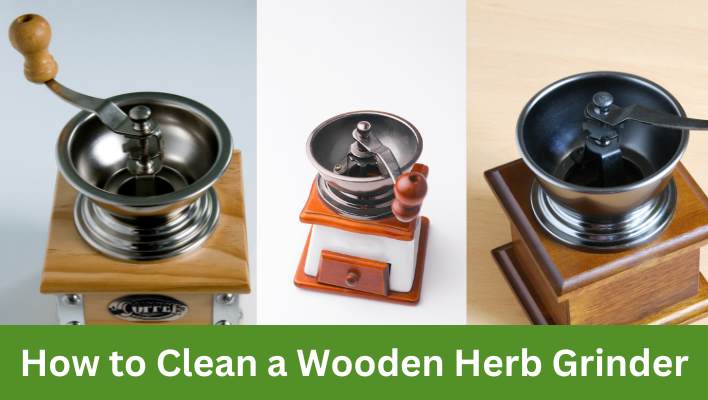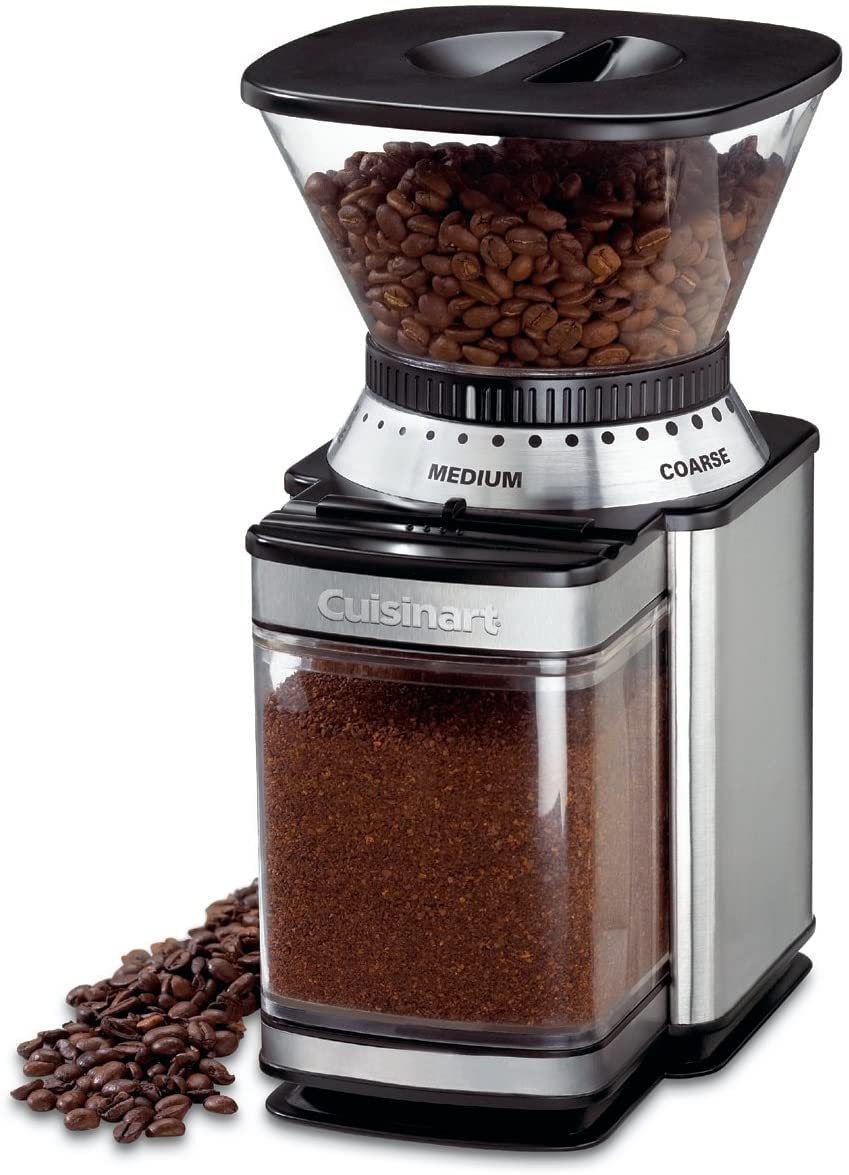Yes, you can grind coffee in a food processor. A food processor is a versatile kitchen appliance that can be used to grind coffee beans into a coarse or fine consistency depending on your preferences.
Whether you are making an espresso or a French press, grinding coffee beans in a food processor can be an affordable and convenient alternative to purchasing a coffee grinder. Without the need for any additional equipment, you can easily achieve freshly ground coffee at home using a food processor.
Simply add the desired amount of coffee beans to the processor, pulse until you reach the desired grind size, and enjoy a flavorful cup of coffee.
Reasons Why You Might Consider Grinding Coffee In A Food Processor

Are you a coffee enthusiast who wants to enjoy a fresh and aromatic cup of joe every morning? While a dedicated coffee grinder is a traditional choice for achieving the perfect grind consistency, you might be surprised to learn that a food processor can also do the job. Grinding coffee in a food processor can offer several advantages. Let’s explore some reasons why you might consider using a food processor to grind your coffee beans.
Convenience And Versatility Of A Food Processor
A food processor is a versatile kitchen appliance that many people already have in their homes. Unlike a coffee grinder, which serves a specific purpose, a food processor offers a wide range of functions such as chopping, pureeing, and blending. By utilizing your food processor to grind coffee beans, you can make the most out of this multi-purpose device, saving both space and money. It eliminates the need for an additional appliance cluttering your countertop.
Cost-effective Alternative To Purchasing A Coffee Grinder
One of the great advantages of using a food processor to grind coffee is the cost-effectiveness. Coffee grinders, especially those with high-quality burrs, can be quite expensive. On the other hand, if you already own a food processor, you can repurpose it for grinding coffee without spending any extra money. This makes it a convenient and affordable option, especially for those on a tight budget or who prefer a minimalist approach to their kitchen appliances.
Read Also: Can A Food Chopper Grind Meat
Ability To Experiment With Different Grind Sizes
When it comes to coffee brewing, the grind size plays a crucial role in determining the flavor and strength of your cup. Different brewing methods require different grind sizes, ranging from coarse to fine. With a food processor, you can easily experiment with various grind sizes by controlling the processing time. This opens up a world of possibilities, allowing you to explore different brewing techniques and customize the taste according to your preference.
Here are some advantages of grinding coffee in a food processor:
- Convenience and versatility of a food processor
- Cost-effective alternative to purchasing a coffee grinder
- Ability to experiment with different grind sizes
Overall, grinding coffee in a food processor offers convenience, cost-effectiveness, and the opportunity to experiment with grind sizes. Whether you choose to use a dedicated coffee grinder or repurpose your food processor, the key is to prioritize freshness and consistency in your coffee grounds. So go ahead and give it a try!
The Potential Drawbacks Of Grinding Coffee In A Food Processor
One of the potential drawbacks of grinding coffee in a food processor is the uneven grind consistency that it can produce. A food processor is primarily designed for chopping, pureeing, and mixing food, and the blades are not optimized for grinding coffee beans. As a result, the coffee grounds may vary in size, which can affect the extraction process and ultimately the flavour of your brewed coffee.

Unlike specialized coffee grinders, which offer various grind settings to achieve the desired consistency, a food processor may not provide that level of control. This means that you may end up with a mix of coarse and fine particles, leading to an inconsistent and potentially under-extracted or over-extracted cup of coffee.
Potential Flavor Contamination
Another concern when grinding coffee in a food processor is the potential flavor contamination. The food processor may retain residues and odors from previously processed ingredients, such as garlic or onions, which can inadvertently transfer to your coffee grounds. These residual flavors can taint the flavor profile of your coffee, resulting in a less than enjoyable cup.
Additionally, food processors may not have an airtight seal, allowing external odors and moisture to penetrate the grinding chamber. Exposure to moisture can cause coffee grounds to clump together and lead to stale coffee. Therefore, it is crucial to thoroughly clean and dry the food processor before grinding coffee to minimize the risk of flavor contamination.
Difficulty In Achieving Fine Grind For Espresso
A food processor may also present challenges when trying to achieve a fine grind suitable for espresso brewing. Espresso requires a very fine grind to extract the rich flavors and aromas effectively. While some food processors have a high-speed setting, they may not be capable of grinding coffee beans finely enough for espresso.
Read Also: How To Grind Beef In A Food Processor
Specialized espresso grinders often have burrs or blades specifically designed to produce a consistently fine grind. These grinders allow you to adjust the grind size precisely to control the extraction process. Attempting to grind coffee beans in a food processor for espresso may result in a grind that is too coarse, leading to weak and flavorless shots.
Exploring Alternatives: Coffee Grinders Vs. Food Processors

When it comes to achieving that perfect cup of coffee, the quality of the grind can make all the difference. Coffee grinders are specifically designed to give you precise control over the size and consistency of your coffee grounds, resulting in a flavorful brew. However, if you don’t have a coffee grinder on hand, you may be wondering if a food processor can do the job. In this article, we will explore the differences between coffee grinders and food processors, and help you make an informed decision about which one is right for you.
Features And Benefits Of Dedicated Coffee Grinders
Dedicated coffee grinders are the go-to choice for coffee enthusiasts who prioritize a high-quality grind in their brewing process. These specialized devices offer a range of features and benefits that make them indispensable for coffee lovers:
- Precision Grinding: Coffee grinders are designed to finely grind coffee beans to your desired consistency. With adjustable settings, you have full control over the coarseness of your grounds, allowing you to experiment with different brew methods.
- Uniformity: A dedicated coffee grinder ensures a consistent grind size, making it easier to extract the flavors efficiently. This consistency promotes even extraction and a more balanced and flavorful cup of coffee.
- Retains Freshness: Coffee grinders typically come with a hopper that tightly seals the beans, preserving their freshness for extended periods. By grinding coffee beans just before brewing, you get to experience the full aroma and flavor that freshly ground coffee offers.
- Convenience: Many coffee grinders come equipped with timers, grind presets, and even automatic shut-off functions, making the grinding process effortless and convenient. Plus, they are specifically designed for coffee grinding, so you can trust that they will deliver optimal results consistently.
Comparison Of Grind Consistency And Flavor Extraction
The grind consistency and flavor extraction play significant roles in the final taste of your coffee. Let’s compare how dedicated coffee grinders and food processors fare in these aspects:
| Grind Consistency | Flavor Extraction | |
|---|---|---|
| Coffee Grinders | Consistent | Effective |
| Food Processors | Inconsistent | Less Effective |
Factors To Consider When Choosing Between A Coffee Grinder And A Food Processor
Before deciding between a coffee grinder and a food processor, it is essential to consider a few key factors:
- Brewing Method: Different brewing methods require different grind sizes. If you prefer espresso or Turkish coffee, a dedicated coffee grinder that can produce finely ground coffee is a must. However, if you typically brew using a French press or a drip coffee maker, a food processor may be more suitable.
- Grinding Volume: If you frequently grind coffee in large quantities, a dedicated coffee grinder with a higher capacity may be more efficient. Food processors, on the other hand, tend to have larger capacities, which can be advantageous if you need to process a variety of ingredients.
- Space and Budget: Coffee grinders come in various sizes and price ranges. Consider the available space in your kitchen and your budget constraints when making your decision.
Ultimately, while a food processor can grind coffee, it may not deliver the same level of precision and consistency as a dedicated coffee grinder. If you are passionate about the perfect cup of coffee and the art of brewing, investing in a coffee grinder will undoubtedly elevate your coffee experience.
Read Also: How To Grind Nuts In A Food Processor?
Tips For Grinding Coffee In A Food Processor
Grinding your coffee beans is a great way to ensure a fresh and flavorful cup of joe. While most people use a coffee grinder for this purpose, you may be wondering if a food processor can do the job. The answer is yes, but there are a few things you need to keep in mind to achieve the best results. In this article, we will explore some essential tips for grinding coffee in a food processor.
Choosing The Right Type Of Coffee Beans
When it comes to grinding coffee in a food processor, the type of coffee beans you choose can have a significant impact on the taste and aroma of the final cup. Different coffee beans have distinct flavors and characteristics, so it’s essential to select the right type that suits your preferences. Whether you prefer a bold and dark roast or a milder and lighter one, make sure to choose high-quality coffee beans that are suitable for your desired flavor profile.
Understanding The Optimal Grind Size For Different Brewing Methods
The grind size of your coffee beans is crucial for achieving the desired flavor when brewing. Different brewing methods require different grind sizes to extract the best flavor from the beans. Here’s a simple guide to determining the optimal grind size for common brewing methods:
| Brewing Method | Grind Size |
|---|---|
| French Press | Coarse |
| Pour Over | Medium |
| Espresso | Very Fine |
Adjusting the grind size can help you achieve the best extraction and flavor for your preferred brewing method. Experimenting with different grind sizes can be a fun and rewarding way to discover your perfect cup of coffee.
Techniques To Ensure A More Consistent Grind
When using a food processor to grind coffee, it’s essential to employ techniques that ensure a more consistent grind. Inconsistent grind size can result in uneven extraction and an inferior-tasting cup of coffee. Here are a few techniques to help you achieve a more consistent grind:
- Grind in smaller batches: Grinding coffee in smaller batches allows for more control and ensures a consistent grind size throughout.
- Pulse instead of continuous processing: Instead of running the food processor continuously, pulse the machine in short bursts. This helps prevent overheating and uneven grinding.
- Shake and scrape the container: Periodically shaking the food processor and scraping the sides and bottom of the container can help redistribute the coffee beans and achieve a more uniform grind.
- Sieve the grounds: After grinding, you can pass the coffee grounds through a fine-mesh sieve to remove any larger particles, resulting in a more consistent grind.
By following these techniques, you can maximize the efficiency and quality of your coffee grinding experience with a food processor.
Frequently Asked Questions On Can You Grind Coffee In A Food Processor
Can I Use a Food Processor Instead Of a Coffee Grinder?
No, a food processor is not recommended as a substitute for a coffee grinder. Coffee grinders are specifically designed for grinding coffee beans finely and evenly, whereas food processors are used for a variety of food processing tasks and may not provide the desired consistency for coffee grounds.
Is It Better To Grind Coffee In A Food Processor Or Blender?
It is better to grind coffee in a burr grinder specifically designed for coffee beans. A food processor or blender can cause uneven grinding and heat up the coffee, potentially affecting the flavor. To preserve the taste and aroma, invest in a quality burr grinder for your coffee beans.
What Can I Use If I Don’t Have A Coffee Grinder?
If you don’t have a coffee grinder, you can try using a blender or food processor instead. Just pulse the coffee beans until they reach your desired consistency. You can also purchase pre-ground coffee or use a mortar and pestle to grind the beans manually.
Can You Grind Coffee In A Cuisinart Food Processor?
Yes, you can grind coffee in a Cuisinart food processor. It is a versatile appliance that can handle coffee beans effectively. Simply add the beans to the processor and pulse until you achieve your desired grind consistency. Enjoy freshly ground coffee for your brewing needs.
Can You Grind Coffee Beans In A Food Processor?
Yes, you can grind coffee beans in a food processor, but the consistency may not be ideal for brewing.
Conclusion
Grinding coffee in a food processor is feasible but comes with drawbacks. While it can save you money and provide a coarser grind, it may produce inconsistent results and affect the flavor profile. To maximize your coffee experience, investing in a dedicated coffee grinder is recommended.
Ultimately, the choice depends on your priorities and preferences. Happy brewing!





